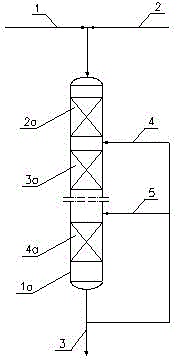Method for producing epoxypropane from cumene hydroperoxide and propylene
A technology of cumene hydroperoxide and propylene oxide, which is applied in the field of propylene oxide production from cumene hydroperoxide and propylene, can solve the problems of reaction temperature rise and achieve the effect of improving selectivity
- Summary
- Abstract
- Description
- Claims
- Application Information
AI Technical Summary
Problems solved by technology
Method used
Image
Examples
Embodiment 1
[0037] according to figure 1 In the technical scheme shown, the raw material contains a mixture of cumene hydroperoxide with a concentration of 35% wt, and the flow rate is 101166.1 kg / h. It is divided into two shares in proportion and enters a two-stage adiabatic fixed-bed reactor respectively. The raw material propylene is 10812.7 kg / hour, circulating propylene 92993.1 kg / hour, mixed with the cumene hydroperoxide mixture entering the first catalyst bed, and under the conditions of reaction temperature 55°C and reaction pressure 3.1MPaG, with Ti / SiO 2 Catalyst contact, liquid phase epoxidation reaction to generate propylene oxide, dimethyl benzyl alcohol and other by-products; the reactants flowing out of the first catalyst bed and the mixture of cumene hydroperoxide entering the second catalyst bed, circulation The streams are mixed, the temperature is controlled at 62°C, and they enter the second catalyst bed, and Ti / SiO 2 Catalyst contact, liquid phase epoxidation reacti...
Embodiment 2
[0040] Same as [Example 1], only the flow rate of circulating propylene and the inlet temperature of the second catalyst bed are changed: the flow rate of circulating propylene is 61995.4 kg / h, the temperature of the second catalyst bed inlet is 66°C, and the others are the same as in [Example 1]. Cumene hydroperoxide weight space velocity 4.5hr -1 , the mol ratio of total propylene and cumene hydroperoxide is 7.1, and the mol ratio of propylene and cumene hydroperoxide at the inlet of the first catalyst bed and the second catalyst bed then reaches 17.0 and 16.9, the first catalyst bed The outlet temperatures of the bed and the second catalyst bed were 87.2°C and 87.2°C respectively, the total conversion rate of cumene hydroperoxide was 99.3%, and the molar selectivity to propylene oxide was 96.0%.
[0041]
Embodiment 3
[0043] Same as [Example 1], only the reactor form is changed: two single-bed adiabatic fixed-bed reactors are connected in series, and the others are the same as [Example 1]. Cumene hydroperoxide weight space velocity 4.5hr -1 , the mol ratio of total propylene and cumene hydroperoxide is 10.2, and the mol ratio of propylene and cumene hydroperoxide at the inlet of the first catalyst bed and the second catalyst bed then reaches 24.2 and 24.1, the first catalyst The outlet temperatures of the bed and the second catalyst bed were 82.6°C and 82.3°C respectively, the total conversion rate of cumene hydroperoxide was 99.3%, and the molar selectivity to propylene oxide was 96.3%.
[0044]
PUM
 Login to View More
Login to View More Abstract
Description
Claims
Application Information
 Login to View More
Login to View More - R&D
- Intellectual Property
- Life Sciences
- Materials
- Tech Scout
- Unparalleled Data Quality
- Higher Quality Content
- 60% Fewer Hallucinations
Browse by: Latest US Patents, China's latest patents, Technical Efficacy Thesaurus, Application Domain, Technology Topic, Popular Technical Reports.
© 2025 PatSnap. All rights reserved.Legal|Privacy policy|Modern Slavery Act Transparency Statement|Sitemap|About US| Contact US: help@patsnap.com

